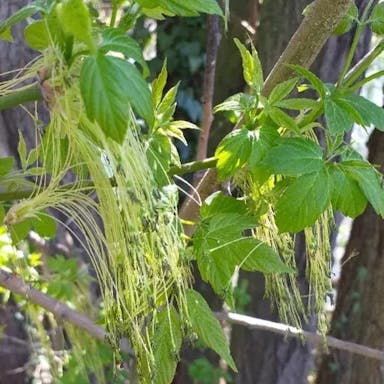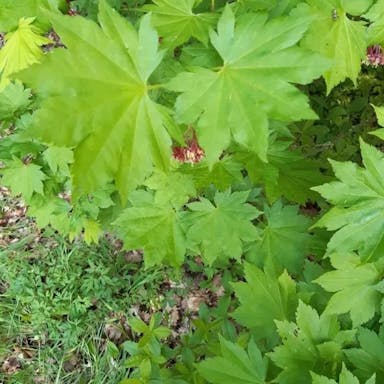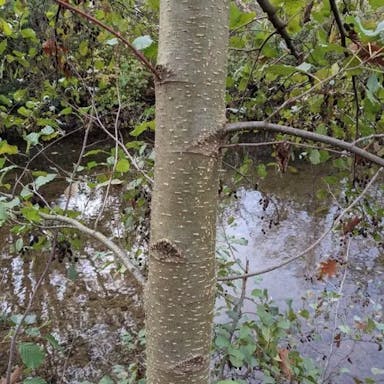American hop-hornbeam, scientifically known as Ostrya virginiana, is a deciduous tree native to eastern North America. The tree can reach 30 to 60 feet in height and features slender, upright growth. Dark green leaves turn yellow come fall. The tree yields tiny flowers in springtime; the male flowers are yellow-green and the females are small. The fruit resembles hops. This tree does well in various types of soil and likes sun to partial shade. It is a hardy tree, tolerating drought and pollution. To conclude, Ostrya virginiana is a deciduous North American tree identified by slim growth, grayish-brown bark, dark foliage, and little hop-like fruit.
American hop-hornbeam
- Scientific name
- Ostrya virginiana
Basic Information
- Betulaceae Family Ostrya Genus American hop-hornbeam Species
- Betulaceae > Ostrya > Ostrya virginiana
- 83%
- The Completeness of This Encyclopedia
Please help us complete the encyclopedia, Terrarium is a encyclopedia service to be completed with everyone in the world. Currently, this page is 83% complete. For more information on how to contribute, please click here.
- Broad-leaved tree
- Indeciduous tree
- Tree
- Height
- 1500cm ~
- Flower Color
- Leaf Color
- Anthesis
- spring
- Sunlight Exposure
Full Sun Long hours of sunlight from morning to afternoon Partial Shade A location in the shade of a tree or where either the morning or afternoon is shaded Full Shade A place where there is no direct sunlight
- Full Sun
- Hardiness Zones
This is an indicator to know to which zone each plant can winter. Knowing the zone of each plant gives you an idea of the cold temperature resistance when grown in the ground without a roof. 2: -42.7 to -40.0 3: -39.9 to -34.4 4: -34.3 to -28.9 5: -28.8 to -23.3 6: -23.2 to -17.8 7: -17.7 to -12.2 8: -12.1 to -6.7 9: -6.6 to -1.1 10: -1.0 to 4.4 11: 4.5 to 10.0
- 4
- Cold resistance
- Excellent
- Heat resistance
- Fair
- Habitat of origin
- United States
- Growth Rate
- Normal
What is American hop-hornbeam (Ostrya virginiana)?
What is American hop-hornbeam (Ostrya virginiana)
Flower meaning
In the communication of flowers, the American hop-hornbeam is resilience and strength. It is determination and perseverance through trouble. Communication through flowers means certain flowers have symbolic significance. The rose can mean love, the daisy can mean innocence. But the American hop-hornbeam always means resilience.
Calendar of American hop-hornbeam (Ostrya virginiana)
Calendar
American hop-hornbeam, also known as Ostrya virginiana is a deciduous tree native to the United States. It typically blooms in the spring season during the months of April and May. The flowering period of American hop-hornbeam usually lasts about two to three weeks. During this time the tree produces small inconspicuous flowers that are not particularly showy. To encourage longer blooming provide the tree with adequate sunlight water and nutrients. Additionally pruning the tree in late winter or early spring can help promote more vigorous growth and increase the chances of abundant flowering. American hop-hornbeam is an important tree species in various ecosystems and is valued for its ornamental qualities.
How to grow American hop-hornbeam (Ostrya virginiana)
Watering
American hop-hornbeam plant watering frequency require season soil condition. Growing spring early fall watering regular maintain moisture. Recommend deep water reach root zone. Achieve slow steady method drip irrigation soaker hose. Frequency depend rainfall soil type water 7-10 day. Hot dry condition frequent water necessary. Dormant late fall winter water less. Allow soil dry slightly watering prevent overwater root rot. Monitoring soil moisture level adjust watering schedule crucial health American hop-hornbeam plant.
Soil and Fertilizer
American hop-hornbeam, also known as Ostrya virginiana, thrives in various soil conditions. Preferably well-drained soils slightly acidic to neutral, pH range 5.5 to 7.0. The soil rich organic matter good moisture retention capabilities. To ensure growth, recommend apply balanced slow-release fertilizer early spring, before new growth begins. Fertilizer nitrogen-phosphorus-potassium ratio 10-10-10 similar. Apply fertilizer evenly around base plant, avoiding direct contact trunk. For established American hop-hornbeam trees, fertilization once year early spring. Apply fertilizer rate 1 pound per inch trunk diameter, up maximum 10 pounds tree. Spread fertilizer evenly within area directly beneath outermost branches. Regular soil testing recommended monitor pH nutrient levels soil. Adjustments based test results maintain optimal soil conditions American hop-hornbeam.
Sunlight and Place
American hop-hornbeam, a thing known as Ostrya virginiana, is a tree native to North America. It shows okay cold hardness, being able to handle low temperatures as low as -20°F (-29°C). However, it also has a good heat hardness, making it good for a wide range of climates. The best temperature for American hop-hornbeam is between 60°F (15°C) and 80°F (27°C). In the summer, this tree likes a sunny place with some shade, as it can handle some sunlight. It is important to note that too much direct sunlight may cause leaf burns. In terms of sunlight time, American hop-hornbeam grows well with at least 4-6 hours of direct sunlight per day. In winter, this tree is resting and can handle cold temps. It does not need any special winter safety steps. When planting, it is suggested to pick a place that has well-drained soil and enough air flow. Overall, American hop-hornbeam is a flexible tree that can fit to various sun openness states, but it grows best with some sunlight and some shade.
Advanced Information of American hop-hornbeam (Ostrya virginiana)
Pruning
Good morning. American hop-hornbeam, also known as Ostrya virginiana, critically obligations pruning and subtract back to preserve its system and advertise fit growth. Precise steps are important to quit dead, impaired, or infectious stems, also to decongest crowded areas. It similarly assists to meliorate air ambulation and sun interference, restricting the possibility of mushroom maladies. The ideal step to prune American hop-hornbeam is during recent winter season or fall, earlier than modern swelling starts. When pruning, it is significant to synthesize pure cuts impartial upper a bud or parallel stem. Shun decreasing extremely end to the main or depart stubs, as this may principal to degeneration and enervate the shrub. Later pruning, it is suggested to abolish any flotsam and use a stratum of mulch environing the foot of the shrub to save dampness and control weed swelling. Regular pruning all some years will assistance preserve the fitness and show of American hop-hornbeam.
Planting and Harvest
American hop-hornbeam, or Ostrya virginiana, grows in eastern North America. This tree often decorates landscapes for appealing trunk and leaves. Give the plant ample room to spread roots when potting. Mix the soil to drain well and poke holes beneath. Partial or full sunlight suits the tree. Keep the dirt moist, not soaked. Feed with slow, balanced fertilizer when spring starts. Repot every few years if outgrown. Gently take from old pot, loosen roots, and put in bigger pot and new soil. Mist leaves sometimes for moisture. Don't overwater or let soil get too dry.
Propagation
American hop-hornbeam propagation achievable via various techniques. Sowing of mature seeds in well-draining soil provides one approach. Keeping soil moist and supplying indirect sunlight critical. Root clump division another option - carefully dig up plant and separate into smaller sections for replanting. Stem cuttings 4-6 inches long also viable when dipped in rooting hormone and planted in suitable soil mix. Leaf cuttings possible too by taking healthy leaves, cutting into sections with veins, and planting in appropriate soil. Leaf harvesting unnecessary for propagation.
Pests and Diseases
American hop-hornbeam, also known as Ostrya virginiana, is susceptible to several pests and diseases. The hop-hornbeam borer can be problematic. This beetle larvae bore into the plant trunk and branches, causing damage and weakness. The hop-hornbeam leafminer insect is another pest. It lays eggs on leaves. Then the larvae tunnel through the leaf tissue, causing discoloration and damage. Regarding diseases, American hop-hornbeam can get leaf spots from various fungi. This shows as dark lesions on leaves, eventually causing defoliation if not treated. Powdery mildew is another fungal disease. It looks like a white powder on leaves and stems. To prevent pests and diseases, keep the plant healthy. Prune dead branches regularly. Also ensure proper watering and fertilizing. Pesticides may help for severe pest infestations. Apply fungicides at first disease signs to prevent spreading. Withering in American hop-hornbeam has various causes depending on the pest or disease. The borer larvae disrupt water and nutrient flow, causing withering. Leaf spots and powdery mildew damage leaves, reducing photosynthesis. Detecting problems early and quick treatment are key to prevent major withering and keep American hop-hornbeam healthy.
Habitat of American hop-hornbeam (Ostrya virginiana)
Habitat
Toxicity of American hop-hornbeam (Ostrya virginiana)
Health Benefits
- edible
- Inedible
- Toxic
- No toxicity
NO DATA
Toxic for dogs and cats
NO DATA
Q&A of American hop-hornbeam (Ostrya virginiana)
- Is there a recommended way to choose American hop-hornbeam?
American hop-hornbeam, scientifically known as Ostrya virginiana, is a deciduous tree native to eastern North America. When choosing seedlings, it is important to choose hale and vigorous plants with well-developed root systems. Look for seedlings that have a directly central leader and well-spaced lateral branches. Avoid seedlings with signs of disease or insect damage. When choosing seeds, choose those that are fresh and viable. Look for seeds that are plump, firm, and free from mold or discoloration. It is recommended to purchase seeds from reputable suppliers or nurseries to ensure quality. There are no particular varieties of American hop-hornbeam mentioned in English-speaking sources. However, it is worth noting that American hop-hornbeam is a species with natural variation in leaf shape and size. When choosing seedlings, you may come across variations in leaf traits. Choose the variety that best suits your aesthetic preferences or specific landscape requirements. Overall, choosing healthy seedlings and viable seeds is crucial for successful establishment and growth of American hop-hornbeam in your garden or landscape.
0
0












